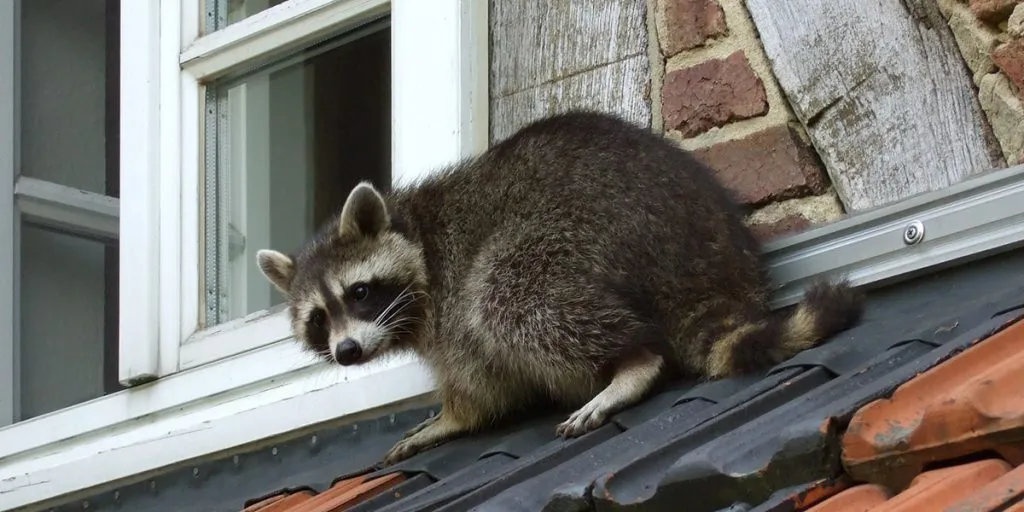If you’re dealing with a raccoon in your attic, getting rid of them can be quite a challenge. The good news is that raccoons don’t stay in hiding spots inside your house all day. That gives you an opportunity to discourage the animals from entering your home.
To get rid of raccoons in an attic, empty and clean the attic space to find out where the raccoons live and strategically place cage traps. To increase the odds of catching the raccoons, block off any places raccoons could enter the attic.
The best course of action is to contact specialized pest removal services in your local area. A professional can help you deal with your raccoon problem more effectively, as well as be more animal-friendly. However, the general steps to get rid of ‘trash pandas’ in the attic will be roughly similar.
1. Locate The Exact Spot Of The Raccoon Den In The Attic
The first thing you need to do is knowing where exactly the raccoons are located. You’ll need to do this whether you’re going to remove the raccoons from your attic yourself, or if you’re calling in the help of a professional.
In order to more precisely locate raccoons in an attic, here are a few things you should do:
- Listen for raccoon sounds: The best way to determine where the raccoons hold up in your attic space, is by listening to their cries. It’s possible to listen through walls and floors, which makes it a less intrusive method to see where the animals are in your house.
- Determine if it’s a raccoon nest: While listening, it’s extremely important to note if there are raccoon baby cries. If you’re dealing with a nest of youngsters, the problems you’re facing are a whole lot bigger. Youngsters will keep coming back.
- Wear protection: Mother raccoons can be aggressive, even towards humans. Wear gloves if you’re dealing with a nest of newborns and keep your face away as much as possible. The mother is likely to lunge at any people threatening her young.
- Remove attic items: Raccoons love hiding in small spaces, which makes an attic full of old items a perfect spot to make a den. Remove the items slowly, one by one. A startled raccoon that feels cornered can be aggressive.
Once you’ve determined where the den is located in your attic, the next step is to find out where the animals enter your house. There are two major strategies you can use to learn this: immediately closing down possible entry points, as well as actively observing on the outside of your roof.
2. Observe Where Raccoons Enter The Attic
The next step is to understand where the animals enter your house. First, it’s important to observe where the raccoons might have entered your attic. A raccoon is able to crawl and fit through openings as small as 3 or 4 inches, which gives you an idea of the opening sizes you should look for.
Raccoons are known to climb trees with ease, and will walk through your gutters in search of a hiding spot. Why, you ask? Attic spaces are relatively warm, which is exactly what these critters will look for.
You could choose to immediately seal any holes larger than 3 inches in diameter. This includes windows and possible spaces underneath roof tiles.
You might want to place a net over the gutters to make it harder for them to enter underneath roof tiles, or walk through the gutters in general. Alternatively, you might choose to keep an obvious path to walk in open and place some cameras. This helps you determine the size and number of raccoons you’re dealing with.
3. Empty And Clean The Attic
Once you know who the culprits are and how they move around, it’s time for some serious cleaning action. If you have raccoons in your attic, the number one most effective thing you can do is to remove all items from the space.
For some people, this will be a monstrous task of epic proportions. For others, it will mean moving around some spare furniture and boxes. You might want to call in the help of friends and family, or a professional cleaning service.
Be aware of the possibility of extreme stench (from droppings or urine), as well as the risk of highly aggressive other raccoons. If you’re dealing with a nest, go straight to a professional removal service. If you’re dealing with adult individuals, the risk is reduced.
4. Set Raccoon Traps In The Attic
It is not only cruel to lock the animals in your attic and let them starve, but it is also unlawful. In many states, the law mandates that raccoons should be caught alive with a humane trap, and released into the wild according to specific procedures.
For choosing the right raccoon trap, this Havahart animal trap model 1079 is widely considered safe and humane. This trap should NOT be used to catch a mother raccoon with babies (these need to be caught by a professional pest control service).
How To Set Raccoon Traps
Please follow the proper procedure! You can’t just place one of these traps in your attic and call it a day. Instead, follow the proper steps to catch and release these wild animals. Here is a general overview:
- Follow the instructions manual: Every trap comes with a guide on how to set up a trap the correct way. Follow these instructions to the letter, in order to succeed without hurting the animal you’re trying to catch.
- Learn about how to release raccoons: Contact the Humane Society or your local state game commission to learn the proper procedures in your area. The law is very strict, so make sure to give them a call.
- Testing, testing, testing: Make sure you’ve set up everything correctly by setting off the trap several times. If the trap works every time, you nailed it.
- Choosing raccoon bait: Fresh fish or meat, sugary fruits like watermelon, corn, or marshmallows will all successfully attract raccoons to your trap. Remember that just like with humans, the taste of an individual raccoon might differ.
- Cover the trap (optional): You can choose to place a breathable cloth over the trap or reduce the shine of the metal to increase the odds of success.
- Set the trap: Place the bait and make sure everything is set up according to the instructions.
- FREQUENTLY check up on the trap: Check up on the trap every hour or so, especially at night when raccoons are most active. It is inhumane to keep them locked up for prolonged periods of time. Relocate and release them in the wild as soon as possible.
- Relocate and release the animal: Keep the cage covered and place it in your car or truck. Quickly relocate the animal once it’s caught to reduce stress. Remember the advice provided to you by the authorities. If they aren’t available at the hour you release the animal, you could contact 24/7 pest control services in your area for quick advice as well.
5. Call Professional Raccoon Removal Services
In case setting a trap is not a proper solution for your situation, the best course of action is to contact a professional. Most states with intrusive raccoons will have specialized pest removal services.
Make sure to read up on other people’s experiences before choosing your pest control company. You’d want a company with experience and expertise. This won’t only increase the odds of success, but will ultimately also be better for the animals involved. Raccoons are clever animals that should be handled with care.
Please note that a regular pest control company is not licensed to catch and release raccoons. It takes a specialized company, which will also be a bit more expensive. But it’s still cheaper than a bunch of raccoons eating away your wall insulation.
Raccoon In Attic FAQ
A lot of people have questions about what to do with a raccoon in their attic space. If you’re dealing with this problem, here are some answers to the most frequently asked questions. If your answer isn’t available in the overview, feel free to contact us using the contact form on this website.
Will Raccoons Leave An Attic On Their Own?
A raccoon will often leave one hiding spot for another, so it will usually stay in an attic space for a single night. It’s possible that raccoons will not leave your attic for several days or weeks, especially in cold winter times. A mother raccoon with young won’t leave an attic for up to 2 months.
When you’re dealing with an adult raccoon in ‘hibernation’, it can take up to 3 to 4 weeks for the animal to leave your attic space. During the coldest days of winter, they will only come out to scavenge for food once every few weeks. That’s when they often change den and leave your attic.
Is It Bad To Have Raccoons In The Attic?
In general, having raccoons in the attic might not seem like a bad thing. However, a raccoon will damage the attic insulation, flooring, roofing and will spread their feces everywhere. This makes having raccoons in the attic highly undesirable.
If you have a mother raccoon with babies, those babies will mature and come back every year to nest again. This will create a cycle of destruction that can degrade and destroy the roofing and inner walls of your house over time.
Do Raccoons Leave The Attic During The Day?
Raccoons are nocturnal animals and will generally leave an attic space during the night. During the day, a raccoon will retreat into the attic to sleep until it gets dark outside.
It does happen that raccoons come out during the day, or when the sun hasn’t set yet. However, raccoons are generally more threatened by predators that eat them when it’s still light outside.
How To Repel Raccoons From The Attic?
To repel a raccoon from entering your attic, fill up any attic holes (especially those larger than 3 to 4 inches in diameter). Other raccoon repellents include the smell of cougar urine, onions, garlic, peppermint oil, or Epsom salt.
Note that raccoons will usually access an attic from the roof, which they will reach by climbing up a tree or fencing. They can jump up to 3 to 4 feet (over 1 meter), which makes it important to reduce access for these distances by cutting tree branches.
How Much Does It Cost To Remove Raccoons From An Attic?
The costs for professional raccoon removal services are determined on a case-by-case basis. Generally, it will cost $400 to $500 USD to remove and relocate a single adult raccoon from an attic.
It might help to get a few quotes from specialized raccoon removal companies in your local area. This will give you the best price and allows you to pick the best available services.
Featured image adapted from: Wikimedia Commons / Carsten Volkwein



